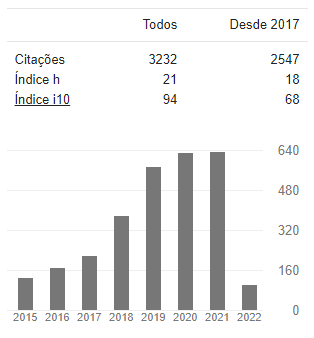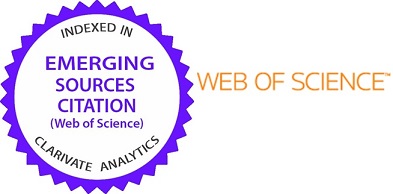ESTUDO DA EFICIÊNCIA DE UM REATOR DE DESCARGA POR BARREIRA DIELÉTRICA (DBD), NA PRODUÇÃO DAS ESPÉCIES ATIVAS DO SEGUNDO SISTEMA POSITIVO DO N2.
DOI:
https://doi.org/10.15628/holos.2015.2955Palavras-chave:
Plasma DBD, Eficiência da descarga, Frequência, Regime difuso, EEO.Resumo
Apesar das inúmeras publicações a respeito da versatilidade da técnica de descarga por barreira dielétrica (DBD), principalmente em aplicações emergentes como descontaminação biológica e química, pouco se apresentou sobre a influência dos parâmetros de processos. No presente trabalho é analisada a influência dos parâmetros do processo sobre as espécies ativas do plasma formado quando ar é utilizado como atmosfera. Analisou-se a influência da distância e voltagem aplicada entre eletrodos, bem como a frequência do pulso aplicado. As análises das espécies foram realizadas diagnosticando o plasma por espectroscopia de emissão óptica (EEO). Esses resultados foram correlacionados com dados da potência consumida no processo de produção de plasma, obtidos a partir das figuras de Lissajous. O equipamento DBD utilizado possui sua máxima eficiência de produção de plasma atmosférico com a distância entre eletrodos fixada em 0,5mm Voltagem de 15 kV e frequência de 500 ou 600 Hz dependendo da espécie ativa que se queira em maior quantidade N2 357nm ou N2 337nm respectivamente .
Downloads
Referências
ALVES JR, C. et al. Nitriding of titanium disks and industrial dental implants using hollow cathode discharge. Surface and Coatings Technology, v. 194, n. 2–3, p. 196-202, 5/1/ 2005.
SOUZA, I. A. DESCARGA EM BARREIRA DIELÉTRICA: CONSTRUÇÃO DE UM REATOR DBD E CARACTERIZAÇÃO MEDIANTE ANÁLISES ÓPTICAS E ELÉTRICAS DO PLASMA PRODUZIDO. 2013. 79 (Mestrado). Programa de Pós-Graduação em Engenharia Mecânica, Universidade Federal do Rio Grande do Norte
KOGELSCHATZ, U. Collective phenomena in volume and surface barrier discharges. Journal of Physics: Conference Series, v. 257, n. 1, p. 012015, 2010
FRIDMAN, G. et al. Applied Plasma Medicine. Plasma Processes and Polymers, v. 5, n. 6, p. 503-533, 2008.
ZHANG, Cheng et al. Surface treatment of polyethylene terephthalate films using DBD excited by repetitive unipolar nanosecond pulses in air at atmospheric pressure. Plasma Science, IEEE Transactions on, v. 38, n. 6, p. 1517-1526, 2010.
RODRÍGUEZ-MÉNDEZ, B. G. et al. PDBD with continuous liquids flows in a discharge reactor. In: Journal of Physics: Conference Series. IOP Publishing, 2015. p. 012060..
KOSTOV, K. G. et al. Treatment of PET and PU polymers by atmospheric pressure plasma generated in dielectric barrier discharge in air. Surface and Coatings Technology, v. 204, n. 18-19, p. 3064-3068, 2010.
DOHERTY, Kyle G. et al. Polystyrene Surface Modification for Localized Cell Culture Using a Capillary Dielectric Barrier Discharge Atmospheric?Pressure Microplasma Jet. Plasma Processes and Polymers, v. 10, n. 11, p. 978-989, 2013.
LAW, Victor J.; DOWLING, Denis P. Active control metrology for preventing induced thermal damage during atmospheric pressure plasma processing of thermal sensitive materials. In: ISCS 2013: Interdisciplinary Symposium on Complex Systems. Springer Berlin Heidelberg, 2014. p. 321-331.
DOHERTY, Kyle G. et al. Polystyrene Surface Modification for Localized Cell Culture Using a Capillary Dielectric Barrier Discharge Atmospheric?Pressure Microplasma Jet. Plasma Processes and Polymers, v. 10, n. 11, p. 978-989, 2013.
PEKÁREK, Stanislav. Experimental study of surface dielectric barrier discharge in air and its ozone production. Journal of Physics D: Applied Physics, v. 45, n. 7, p. 075201, 2012.
KOGELSCHATZ, U.; ELIASSON, B.; EGLI, W. Dielectric-barrier discharges. Principle and applications. Journal de physique. IV, v. 7, n. 4, p. C4.47-C4.66, 1997.
HEINLIN, Julia et al. Plasma medicine: possible applications in dermatology. JDDG: Journal der Deutschen Dermatologischen Gesellschaft, v. 8, n. 12, p. 968-976, 2010.
CHERUTHAZHEKATT, S. et al. Gas plasmas and plasma modified materials in medicine. Journal of Applied Biomedicine, v. 8, n. 2, p. 55-66, 06/01/ 2010.
HAIYAN, He et al. Cold deposition of large-area amorphous hydrogenated silicon films by dielectric barrier discharge chemical vapor deposition. Thin Solid Films, v. 519, n. 15, p. 5038-5042, 2011.
DA PONTE, G. et al. Atmospheric pressure plasma deposition of organic films of biomedical interest. Surface and Coatings Technology, v. 205, Supplement 2, n. 0, p. S525-S528, 2011.
KOSTOV, K. G. et al. Bacterial sterilization by a dielectric barrier discharge (DBD) in air. Surface and Coatings Technology, v. 204, n. 18-19, p. 2954-2959, 2010
DAESCHLEIN, G. et al. Cold plasma is well-tolerated and does not disturb skin barrier or reduce skin moisture. JDDG: Journal der Deutschen Dermatologischen Gesellschaft, v. 10, n. 7, p. 509-515, 2012
BRUGGEMAN, Peter et al. Optical emission spectroscopy as a diagnostic for plasmas in liquids: opportunities and pitfalls. Journal of Physics D: Applied Physics, v. 43, n. 12, p. 124005, 2010.
MAHONEY, J. et al. Electrical and optical emission measurements of a capillary dielectric barrier discharge. Eur. Phys. J. D, v. 60, n. 3, p. 441-447, 2010.
FANELLI, F. Optical Emission Spectroscopy of Argon–Fluorocarbon–Oxygen Fed Atmospheric Pressure Dielectric Barrier Discharges. Plasma Processes and Polymers, v. 6, n. 9, p. 547-554, 2009.
MARCEL, H. H.; ET AL. Influence of the Air Humidity on the Reduction of Bacillus Spores in a Defined Environment at Atmospheric Pressure Using a Dielectric Barrier Surface Discharge. Plasma Processes and Polymers, p. NA, 2009.
NIU, Z. et al. Repetitive nanosecond-pulse dielectric barrier discharge and its application on surface modification of polymers. Surface and Coatings Technology, n. 2012.
SATO, T. et al. Generation and Transportation Mechanisms of Chemically Active Species by Dielectric Barrier Discharge in a Tube for Catheter Sterilization. Plasma Processes and Polymers, v. 5, n. 6, p. 606-614, 2008.
SCHMIDT, M. Š. A. V. P. A. J. Optical and electrical characteristics of a single surface DBD micro-discharge produced in atmospheric-pressure nitrogen and synthetic air. Plasma Sources Science and Technology, v. 20, n. 2, p. 025009, 2011.
LUO, Y.; GE, S.-R. Load Dependence of Nanohardness in Nitrogen Ion Implanted Ti6Al4V Alloy and Fractal Characterization. Journal of China University of Mining and Technology, v. 17, n. 3, p. 363-367, 9// 2007.
KANG, W.-S. et al. Atmospheric-pressure cold plasma jet for medical applications. Surface and Coatings Technology, v. 205, Supplement 1, n. 0, p. S418-S421, 12/25/ 2010.
QIU, X. et al. Spectroscopic study of dielectric barrier discharges in cellular polypropylene ferroelectrets. Applied Physics Letters, v. 91, n. 13, p. 132905-3, 09/24/ 2007.









































